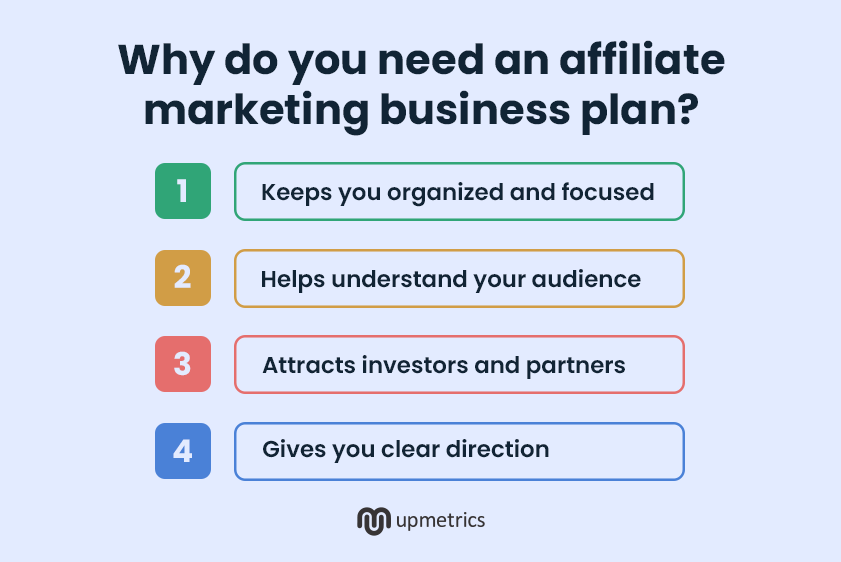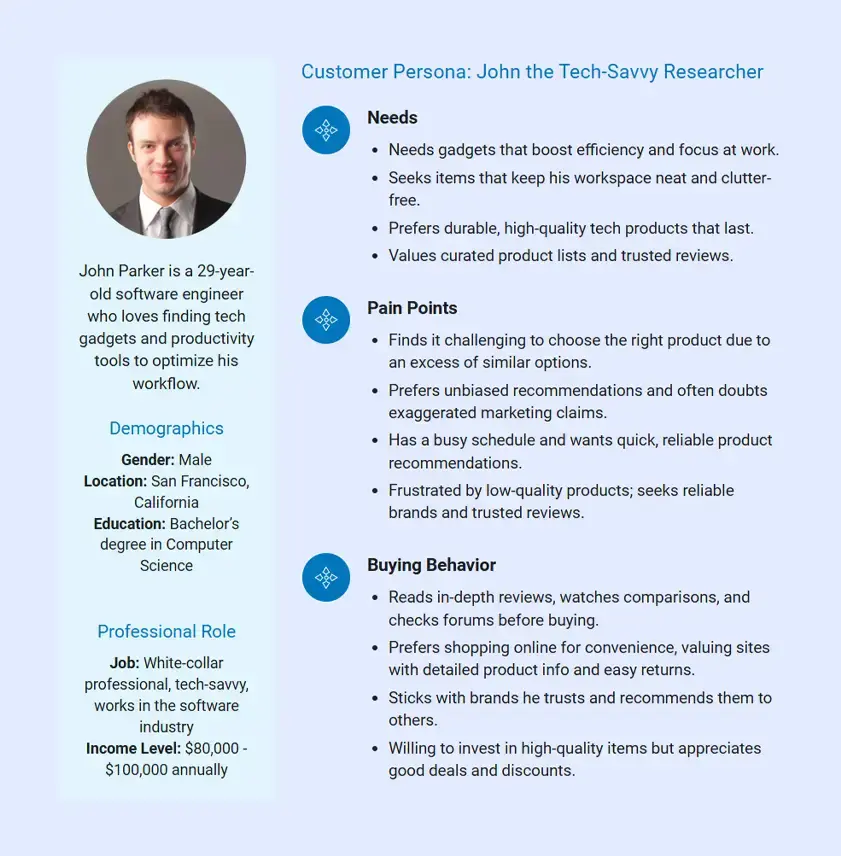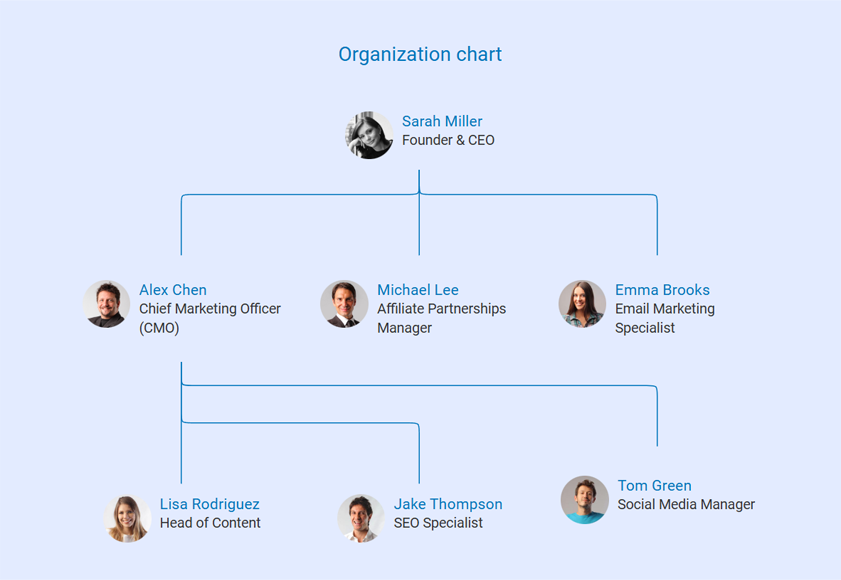Starting and running your own affiliate marketing business can be an exciting venture. It’s full of great potential to make money online!
But before you jump into a niche (like fitness, lifestyle, or tech) and promote those products, it’s integral to keep a solid business plan ready. It helps you bring in potential partners, attract investors, and scale your operations effectively.
Wondering how to draft your plan?
No worries! Check out this affiliate marketing business plan template that walks you through the essentials of creating an effective plan, including why it matters, and a free sample plan for your reference.
Sounds good? Let’s get started!
What is an affiliate marketing business plan?
An affiliate marketing business plan is a professionally written structured document. It clearly outlines the most important aspects of your affiliate marketing, like goals, marketing strategies, product categories, revenue forecasts, and actionable steps to make it successful.
This plan sets a strong foundation for creating content, connecting with your audience, and earning commissions. All in all, it’s a handy tool to guide your journey while staying on track, even if you’re working solo.
Why do you need an affiliate marketing business plan?
Whether you’re planning to launch a new affiliate marketing business or looking to grow your current setup, you’ll need to keep a well-structured business plan. Here’s why it’s so important:

Keeps you organized and focused
Running affiliate marketing involves a lot of things to consider, from content creation to tracking your earnings.
At that time, a good plan keeps you organized and helps you focus on tasks and strategies that work. So, you’re not wasting time on random efforts.
Helps understand your audience
Knowing your target audience is really worthwhile to make your affiliate marketing work. And, writing a plan instills you to think about who you’re targeting and get clear on what their needs are.
Furthermore, you can easily understand where they spend their time online and most importantly, devise strategies that resonate with them and build trust.
Attracts investors and partners
If you want to attract private investors or even partner with other brands, having a solid plan in hand shows you’re serious about your business.
It’s also proof that you’ve done your homework—thought through every business aspect and built a clear strategy. This builds trust and makes them more likely to get on board and work with you.
Gives you clear direction
A well-written business plan lets you define short-term as well as long-term goals clearly. Whether it’s about growing your loyal audience or hitting a certain income level.
This will remove the guesswork and give you a clear path to follow, knowing exactly where you’re going and how to get there.
Simply put, a well-thought-out business plan serves as your roadmap that navigates you through an ever-evolving market and keeps you on track as new opportunities pop up.
Now, without further ado; let’s proceed to the sections of the affiliate marketing business plan.
How to write a business plan for affiliate marketing?
While writing an affiliate marketing business plan, it’s vital to cover all the necessary elements and sections that articulate your business idea clearly.
Here’s a step-by-step guide to help you create a winning business plan for affiliate marketing:
1. Executive summary
The executive summary is a quick, concise overview of your entire affiliate marketing business plan.
Think of it as a teaser to the rest of your plan—showing what your business is all about and where exactly you’re headed. So, keep it short, simple, and compelling to build a strong first impression.
While planning this section, consider including the following key elements:
- The specific niche you’ll focus on
- Your goals and target audience
- Affiliate partnerships
- Products or services you plan to promote
- Content and promotion strategy
- Financial highlights
Overall, this section clearly summarizes all the essential aspects of your affiliate marketing business, giving potential investors a clear snapshot of why it matters and what your goals are.
2. Business overview
Next, describe your affiliate marketing business in a bit more detail. This will help readers (whether potential investors or partners) get a better understanding of your affiliate marketing services.
Begin with a clear explanation of why you chose your niche and what makes your affiliate marketing approach unique. For example:
Are you focusing on a specific product category (eco-friendly products)? Maybe you’re targeting young adults who really care about sustainability and value genuine, well-researched recommendations.
Also, talk about your brand’s personality and the value you bring to the table, especially when you’re entering a competitive landscape.
Lastly, wrap it up with your growth plans and main goals, like monthly revenue or audience growth.
In short, this business overview section offers a well-rounded picture of your business, which helps build trust and confidence in what you offer. So, be real and make people want to learn more.
3. Market analysis
A thorough market analysis is crucial to understand the field you’re getting into. It provides valuable insights into your target audience, industry trends, as well as key competitors.
To make this section more impactful, dive deep into the data—don’t just assume you know the market.
Research who your target audience is and who your potential customers are within your niche (chosen industry). Explore a few important details about them, like needs, interests, or preferences.

After that, mention any current trends you’ve noticed within your niche. Maybe your audience is seeking sustainable products, or they rely heavily on product reviews. Are there gaps you’re filling or ways you’ll stand out?
Finally, list a few main competitors and highlight what they’re doing well or where they’re lacking. This will allow you to do things differently and get a competitive edge.
4. Products and service offerings
Now, shed light on the types of products or services you’ll promote as an affiliate and why they’re relevant to your target audience. Highlight any specific brands or affiliate programs you’re excited to work with.
Try to be selective here!
Then, outline the product categories you’ll focus on, like fitness equipment or organic skincare. Plus, explain why these products align with your audience’s needs and values.
Ensure that you focus on products you genuinely believe in and that fit well with your brand. Your audience will appreciate quality over quantity.
Doing so will help you showcase to potential investors or stakeholders that you’ve thought carefully about what your audience wants and how you’re going to benefit them.
5. Sales and marketing strategy
Well, this section would be your game plan for reaching people and encouraging them to see (click!) your affiliate links. It covers strategies you’ll use to drive traffic and promote your affiliate products, including
- Content marketing
- Search Engine Optimization (SEO)
- Social media advertising
- Live Q&As hostings
- Email newsletters
- Or anything else to get your name out.
Moreover, illustrate how all these strategies help you create a strong, engaging experience for your audience.
It’s advisable to focus on just one or two platforms where your audience is most active rather than spreading yourself thin across five. Building a consistent, reliable presence helps you connect more deeply with your followers and keep them coming back for more.
6. Management team
Even if you’re a solo entrepreneur or just starting out, introduce yourself here in this section. Share your roles and responsibilities, industry experience, skills, and expertise.
However, if you’ve got several team members, like content creators, SEO experts, or marketing managers, shed light on them.
Explain how each member fits their roles. Mention how they add value to your business. Jot down their responsibilities, educational qualifications, as well as work experience.
Further, illustrate your organizational chart to define the hierarchical structure and how key roles are interconnected. For instance:

If you have external advisory board members, introduce them and explain their roles.
7. Operations plan
The next section is all about the day-to-day stuff—how you’ll keep the business running smoothly. It covers daily, weekly, or monthly operations and activities of your affiliate marketing business.
So, consider describing the following operational aspects in your plan:
- Content creation schedules
- Website maintenance
- Affiliate link performance monitoring
- Audience engagement
- Tools or resources you’ll use
In simple words, this operations plan is like your business’s routine. Thus, keep it practical. A realistic schedule is better than an overambitious one that leads to burnout.
8. Financial plan
Finally, here’s where you’ll need to take an honest look at your financial projections for the next 3-5 years of operation.
Your affiliate marketing financial plan not only keeps you financially grounded but also lets you forecast revenue and manage cash flows while evaluating your business’s profitability.
The following are a few critical financial statements and reports you must include:
- Profit and loss statement
- Cash flow statement
- Balance sheet
- Break-even analysis
- Funding requirements and use of funds
Besides these financial projections, list any startup costs (like website hosting or tools for content creation), ongoing expenses, and the revenue you hope to earn from affiliate commissions.
For a better understanding, you may take below financial forecasts as a reference to formulate yours:
Revenue projections
| Metrics | Year 1 | Year 2 | Year 3 |
|---|---|---|---|
| Monthly Visitors | 10,000 – 20,000 | 20,000 – 40,000 | 40,000 – 80,000 |
| Conversion Rate | 2.5% | 3% | 3.5% |
| Conversions per Month | 250 – 500 | 600 – 1,200 | 1,400 – 2,800 |
| Average Commission | $20 | $22 | $25 |
| Monthly Revenue | $5,000 – $10,000 | $13,200 – $26,400 | $35,000 – $70,000 |
| Annual Revenue | $60,000 – $120,000 | $158,400 – $316,800 | $420,000 – $840,000 |
Expense forecasts
| Expense Type | Year 1 (Monthly) | Year 1 (Annual) | Year 2 (Monthly) | Year 2 (Annual) | Year 3 (Monthly) | Year 3 (Annual) |
|---|---|---|---|---|---|---|
| Content Creation | $1,500 | $30,000 | $2,000 | $36,000 | $2,500 | $54,000 |
| Advertising & Promotions | $2,000 | $24,000 | $3,000 | $48,000 | $4,000 | $72,000 |
| Software & Tools | $500 | $6,000 | $600 | $7,200 | $800 | $9,600 |
| Operational Expenses | $200 | $2,400 | $300 | $3,600 | $400 | $4,800 |
| Total Monthly Expenses | $4,200 | $50,400 | $5,900 | $70,800 | $7,700 | $92,400 |
Cash flow statement
| Metrics | Year 1 | Year 2 | Year 3 |
|---|---|---|---|
| Revenue | $60,000 – $120,000 | $158,400 – $316,800 | $420,000 – $840,000 |
| Expenses | |||
| Content Creation | $18,000 | $24,000 | $30,000 |
| Advertising & Promotions | $24,000 | $36,000 | $48,000 |
| Software & Tools | $6,000 | $7,200 | $9,600 |
| Operational Expenses | $2,400 | $3,600 | $4,800 |
| Total Expenses | $50,400 | $70,800 | $92,400 |
| Net Cash Flow | $9,600 – $69,600 | $87,600 – $246,000 | $327,600 – $747,600 |
| Cumulative Cash Flow | $9,600 – $69,600 | $97,200 – $315,600 | $424,800 – $1,063,200 |
Profit & loss projections
| Metrics | Year 1 | Year 2 | Year 3 |
|---|---|---|---|
| Total Revenue | $60,000 – $120,000 | $158,400 – $316,800 | $420,000 – $840,000 |
| Gross Profit | $60,000 – $120,000 | $158,400 – $316,800 | $420,000 – $840,000 |
| Operating Expenses | |||
| Content Creation | $18,000 | $24,000 | $30,000 |
| Advertising & Promotions | $24,000 | $36,000 | $48,000 |
| Software & Tools | $6,000 | $7,200 | $9,600 |
| Operational Expenses | $2,400 | $3,600 | $4,800 |
| Total Operating Expenses | $50,400 | $70,800 | $92,400 |
| Net Operating Profit | $9,600 – $69,600 | $87,600 – $246,000 | $327,600 – $747,600 |
| Profit Margin | 16% – 58% | 55% – 78% | 78% – 89% |
If applicable, think about possible risks—like changes in commission rates or market shifts, and how you’ll handle them. Knowing these challenges beforehand will help you protect your business from unexpected down runs.
Download free affiliate marketing business plan template
So, are you all set to draft your affiliate marketing business plan from scratch? But need a little help with that? No worries; download our free affiliate marketing business plan template in PDF.
This template will offer a ready-made structure to follow and help you create a detailed business plan for your affiliate marketing services. Just download it and customize it as per your business-specific requirements.
The Quickest Way to turn a Business Idea into a Business Plan
Fill-in-the-blanks and automatic financials make it easy.
Conclusion
Let’s wrap up! We’ve discussed all the key aspects of an affiliate marketing business plan as well as how to draft each of them. Plus, we’ve provided a free sample plan to get started.
So, now it should be much easier for you to draft your very own plan.
But if you find yourself getting stuck or need extra support along the way, try using our AI-powered business plan software—Upmetrics! It’ll simplify the entire planning process and let you generate your plan in just a few minutes.
Don’t wait longer; head start your business planning with us!



